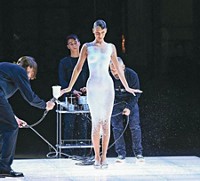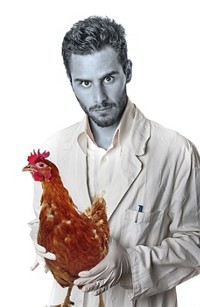Advertisement
Grab your lab coat. Let's get started
Welcome!
Welcome!
Create an account below to get 6 C&EN articles per month, receive newsletters and more - all free.
It seems this is your first time logging in online. Please enter the following information to continue.
As an ACS member you automatically get access to this site. All we need is few more details to create your reading experience.
Not you? Sign in with a different account.
Not you? Sign in with a different account.
ERROR 1
ERROR 1
ERROR 2
ERROR 2
ERROR 2
ERROR 2
ERROR 2
Password and Confirm password must match.
If you have an ACS member number, please enter it here so we can link this account to your membership. (optional)
ERROR 2
ACS values your privacy. By submitting your information, you are gaining access to C&EN and subscribing to our weekly newsletter. We use the information you provide to make your reading experience better, and we will never sell your data to third party members.
Education
Living, Breathing Rainforest, Mighty Materials on Display, a Little Shut-eye; Great Wall of Rice?, Department of Obscure Information
by Linda Wang
March 14, 2005
| A version of this story appeared in
Volume 83, Issue 11
The book, published by the Center for American Places in association with Laguna Wilderness Press, contains 100 striking images that Burchfield made by placing plant cuttings directly on aged black-and-white photographic paper and letting the interaction of sunlight, rain, temperature, and each plant's inherent moisture and chemistry play out freely in prolonged exposures.
"Rather than scientific description or environmental polemic, the lumen prints confront us with the visual representation of the Amazon's most elemental truth: natural process," writes Jonathan Green, director of the California Museum of Photography at the University of California, Riverside, in the introduction.
A new exhibit on high-performance materials will open this April at the Smithsonian Institution's Cooper-Hewitt, National Design Museum, in New York City. "Extreme Textiles: Designing for High Performance" will spotlight about 150 applications of highly engineered--not to mention visually compelling--materials in areas such as medicine, transportation, aerospace, and the environment.
U.K.-based textiles company Ellis Developments, for example, is using embroidery machines to create beautiful yet surprisingly strong artificial ligaments, reports Jude Stewart in the March/April issue of International Design magazine. "Embroidery machines can compose stitches to match the pattern of natural muscle fibers precisely and with a minimum amount of material," Stewart explains.
The exhibit will also showcase advances in nanotechnology. In a technique called electro-spinning, nanoscale fibers are used to create nonwoven fabrics. On display will be an electro-spun mask developed by the U.S. Army's Natick Soldier Center. The textiles show will run from April 8 to Oct. 30.
An 81-year-old buddhist monk in Thailand accidentally glued his eyes shut when he mistook a tube of superglue for eye drops, according to an Associated Press report. Doctors partially restored his sight after two operations in which they used acetone to dissolve the glue.
In other news from Asia, researchers in China have found evidence to support the legend that ancient Chinese craftsmen used glutinous rice porridge as an ingredient in building ramparts. According to CNN. com, researchers found that, in chemical tests, mortar from an ancient wall around the city of Xi'an reacted similarly to sticky rice. The finding brings speculation that the Great Wall may also contain rice.
The following tidbits about underrated inventions appeared in the January/February issue of Mental_Floss magazine:
◾ PEZ candies were originally marketed as a way to stop smoking. In fact, the inventor designed PEZ dispensers to look like lighters, so PEZ users could flick their lighters and pop peppermints instead.
◾ Cruise control, invented by a blind man named Ralph Teetor, was introduced in 1958 in selected Chrysler models. At the time, it was an $86 option known as "Auto-Pilot."
◾ Liquid paper was invented in 1951 by a secretary named Bette Nesmith. Frequent typos inspired Nesmith to bring to work a nail polish bottle filled with white tempera paint. Her invention caught on and was first known as "Mistake Out."
This week's column was written by








Join the conversation
Contact the reporter
Submit a Letter to the Editor for publication
Engage with us on Twitter